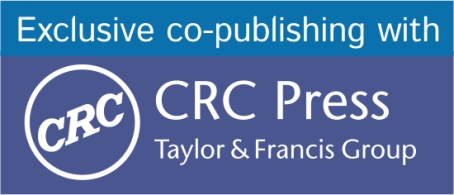|
|
Now Available in Paperback Microbial lipases are industrially important and have gained their attention due to their stability, selectivity, and broad substrate specificity. Lipases are used as a medicine and also aid in indigestion, heartburn, allergy to gluten in wheat products (celiac disease), Crohn’s disease, and cystic fibrosis. This new volume, Lipase: An Industrial Enzyme Through Metagenomics, considers the industrial demand for new sources of lipases with different catalytic characteristics that stimulate the growth and development isolation of new strains. The volume narrates the challenging metagenomic approach with the isolation of the lipase gene, its cloning into Escherichia coli, culture of the recombinant bacteria, and extraction and assessment of the lipase enzyme. Lipase-producing bacteria have been found in different habitats, such as industrial wastes, vegetable oil processing factories, dairy plants, and soils contaminated with oil and oil seeds among others. This volume is the effort of the authors to document the scientific findings carried out over the last eight years in the area of un-culturable soil microorganisms. The book presents the physicochemical features of lipases and their specific applications in different commercial industries. The in-depth study looks at metagenomics for lipases from all angles and provides a truly informative resource. It describes the biochemical characterization of lipase enzymes with the high activity in the presence of 1% tributyrin. The book also highlights the maximum activity of the enzyme at temperature 37°C and pH 7.5 in the presence of the divalent cations Ca2+, Mn2+, Zn2+ and Fe2+. CTAB, gum arabic, NaCl and organic solvents like ethanol, 1-propanol, acetone, acetonitrile, glycerol and DMSO. A wide review has been presented in the book on lipase enzymes purified from a large collection of microbes present in soil, seawater, waste-dumping sites, animal systems (including human beings), and the atmosphere. Stability of enzymes over changing environments of the industry is indeed a big issue, and the book deals at length with the changing temperatures and pH and metal ion concentrations. The book also highlights the antifungal and antibacterial activity of the lipase enzyme. Key features:
CONTENTS: About the Authors / Editors: B. K. Konwar, PhD Professor, Department of Molecular Biology and Biotechechnology, Tezpur University (Central), Assam, India B. K. Konwar, PhD, is currently Professor in the Department of Molecular Biology and Biotechechnology at Tezpur University (Central), Assam, India. He obtained his MSc agricultural degree in plant breeding and genetics from Assam Agricultural University, Jorhat, Assam, India. He has worked as a lecturer, assistant professor, and associate professor at the university. His PhD in plant biotechnology is from the Imperial College of Science, Technology and Medicine, University of London, United Kingdom. He was formerly affiliated with the Tocklai Experimental Station, Tea Research Association, Jorhat, Assam, India, as a Senior Scientist (Botany and Biotechnology). Other appointments include Professor and Department Head, Molecular Biology and Biotechnology at Tezpur University (Central), Napaam, Tezpur, Assam, India; Head of the Centre for Petroleum Biotechnology, DBT (DST, Govt of India; Dean, School of Science and Technology, Tezpur University; and Vice-Chancellor, Nagaland University (Central), HQ: Lumami (campuses: Meriema, Medziphema, Dimapur), Nagaland, India. Dr. Konwar has carried out 12 research projects of national importance as the principal investigator and has supervised over 40 MSc students who carried out research projects at Assam Agricultural University and Tezpur University. He and his research group so far deposited 11 gene (DNA) sequences in national/international gene banks and have published 139 research papers in reputed and impact factor bearing (1-6) international/national journals, along with many papers in seminars and onference proceedings in India and abroad. He published more than 130 popular science, environment, biotechnology, history, national integration, higher education, research needs, and other articles in various Assamese magazines and newspapers, as well as more than 30 scientific articles in English magazines in addition to several books, booklets, and book chapters. Kalpana Sagar, PhD Research Associate, Delhi University, India Kalpana Sagar, PhD, is currently a Research Associate at Delhi University. She has earned her PhD in molecular biology and biotechnology from Tezpur University under the supervision of Prof. B. K. Konwar. |

 Follow us for the latest from Apple Academic Press:
Follow us for the latest from Apple Academic Press:
AAP WELCOMES PROF. MOHAMMED KUDDUS, PhD, AS AAP’S NEW ACQUISITIONS EDITOR for books on biotechnology, enzymology, microbiology, bioinformatics, bioremediation, biomedical technology, value-added products etc. Dr. Kuddus is Head of the Department of Biochemistry at the College of Medicine, University of Hail, Kingdom of Saudi Arabia. He is listed in Elsevier/Stanford University World’s Top 2% Scientists. He seeks book proposals from potential editors to consider for publication with Apple Academic Press. Contact: kuddus@appleacademicpress.com for more information.
AAP welcomes Dr. Maulin P. Shah as AAP’s new acquisitions editor for books on Applied Microbiology, Environmental Biotechnology and Waste Management. Dr. Shah, a Scientist in the Industrial Wastewater Research Lab at Enviro Technology Ltd., India. seeks book proposals to consider for these topics and related areas: applied microbiology, environmental biotechnology and waste management, including environmental pollution, wastewater treatment, bioenergy, biofuel, circular economy, leachate treatment activated sludge process, environmental microbiology, agricultural microbiology, advance oxidation process, bio-electrochemical systems, bacterial genomics for wastewater treatment, and heavy metal remediation. maulinshah1979@gmail.com for more information. AAP is pleased to announce Shrikaant Kulkarni, PhD, as our new Senior Commissioning Editor for books in the areas of Polymer Sciences, Chemical Sciences, Nuclear Sciences, and Material Sciences. Dr. Kulkarni is Adjunct Professor, Faculty of Business, Victorian Institute of Technology, Melbourne, Australia; and Adjunct Professor, Centre of Research Outcome and Impact, Chitkara University, Punjab, India. You can reach him at Email: srkulkarni21@gmail.com for more information. New Book Series: AAP Series on Waste Biomass Valorization will explore the transformation of biomass resources into valuable products, addressing the growing need for sustainable alternatives to fossil fuels and non-renewable resources. For more information and to propose a book, please visit: Click here Congratulations to Hafiz Ansar Rasul Suleria, PhD, for receiving the Dean’s Award for Excellence in Research from the University of Melbourne, Australia, in recognition for his exceptional performance and strong commitment to advanced research in food science. Dr. Suleria is editor of AAP’s book series Innovations in Plant Science for Better Health: From Soil to Fork. For more information, visit: Click here Congratulations to Dr. Christian Mancas. His book Conceptual Data Modeling and Database Design: A Fully Algorithmic Approach was one of the 6 Best Data Modeling ebooks for Beginners by BookAuthority, a leading site for book recommendations. For more information, visit: Click here COMMENTS FROM AAP EDITORS AND AUTHORS AAP book title: Advances in Audiology and Hearing Science (2-volume set) “I have collaborated with AAP during the process of bringing my two-volume editing work to a final publishing phase. AAP support has been truly important throughout the initial and final stages of the book. While the majority of the publishing work is done at the early stages, the final touches that include the last-minute corrections of the authors are extremely crucial to the quality the book tries to convey. The assistance of AAP during the last stages of corrections and communication with the authors was a very positive contributor to my state of mind during those stressful moments. I recommend the publishing experience with AAP to other editors of scientific material.” —Stavros Hatzopoulos, PhD, Hearing Science Laboratory, University Hospital of Ferrara, Ferrara, Italy AAP book title: Nanotechnologies: The Physics of Nanomaterials (2-volume set) “I was very pleased with the interaction and support of the team at Apple Academic Press. They provided me with regular and useful information and updates throughout the publishing procedure. I am also very happy with the final product, which is of good quality. The books are now available and are professionally distributed through the various channels. I would like again to thank the team at AAP for all their hard work and support.” —David Schmool, PhD, Director, Groupe d’Etude de la Matière Condensée GEMaC, National Centre for Scientific Research, Université de Versailles/Saint-Quentin, Université Paris-Saclay,Versailles, France AAP book title: Physiology of Molluscs (2-volume set) “I have enjoyed the full benefit of support, encouragement, and kindness from the members of AAP I have had the pleasure of being associated with. In the same vein, I hope AAP was satisfied with the book series I have edited in advancing the knowledge. It has been a great journey and was a great pleasure and satisfaction. Advancing scholarship through publications is one of the best routes publishers can take, and I would hold AAP as one of the best ones.” —Saber Saleuddin, PhD, University Professor Emeritus, Department of Biology, York University in Toronto, Ontario, Canada AAP book title: Green Chemistry and Sustainable Technology: Biological, Pharmaceutical, and Macromolecular Systems “It had been my pleasure to work with the production team of Apple Academic Press for almost a decade. The best presentation of our work was due to their hard work and with careful scrutiny. I am sure that every one of them takes extra pains to publish the book nicely, maintaining the quality and timeliness. It was a rewarding experience to work with AAP. I would like to publish more with AAP on my upcoming projects in future also.” —Prof. Suresh C. Ameta, Professor of Eminence (Distinguished Professor), Faculty of Science, PAHER University, UDAIPUR, India AAP book title: New Frontiers in Nanochemistry, 3-volume set, plus many others "Publishing a book, either as author or editor, is a journey from the initial vibration to the piece of knowledge towards the present future of humanity at large. Such a journey is about climbing and tunneling, about diving and driving through, about inspiration and tuning, about hard working in every instance; and it is also about time. Very few Global Publishers have the wisdom and patience and kindness and openness to authors, contributors, and readers while being truly crafting oriented as Apple Academic; yet all is about people and their education, vision and assumed mission; the Apple Academic Team heartily succeed that in achieving the world class scholarly acclaim by the quality involvement in all chain of plus value added with each publishing event. Hearty Compliments! Excelsior Apple Academic!" —Mihai V. Putz, PhD, Dr.-Habil., MBA, Professor, Faculty of Chemistry, Biology, Geography, Laboratory of Computational and Structural Physical Chemistry for Nanosciences and QSAR, West University of Timi?oara; PI-1, Laboratory of Renewable Energies - Photovoltaics, National Research and Development Institute for Electrochemistry and Condensed Matter (INCEM), Timi?oara, Romania AAP book title: The Chemical Century: Molecular Manipulation and Its Impact on the 20th Century “All my experiences with AAP have been very positive. I entrusted AAP with the publication of The Chemical Century: Molecular Manipulation and Its Impact on the 20th Century and found the quality of the book that they produced to be excellent. My two contacts at the company were very responsive and efficient throughout the publication process.” —Richard J. Sundberg, PhD, Professor of Chemistry, University of Virginia, Charlottesville, Virginia, USA AAP book titles: Medical Tourism and Wellness: Hospitality Bridging Healthcare (H2H)© and Medical Travel Brand Management: Success Strategies for Hospitality Bridging Healthcare (H2H) “I have enjoyed my scholarly creative work with Apple Academic Press. They have been timely, creative, and very helpful for my two books with them. I encourage you to consider publishing your work with AAP.” —Frederick DeMicco, PhD, RDN, Executive Director and Professor School of Hotel and Restaurant Management, Northern Arizona University, Flagstaff, Arizona AAP book title: The Chemical Evolution of Phosphorus: An Interdisciplinary Approach to Astrobiology “I’m very pleased with the books you have edited. It shows a very good and careful work by everyone involved along the whole production process, and so the final result is a beautiful piece: it has come out as a very nice and appealing book, easy to handle and read, .... and hopefully of interest for people from diverse related fields!” —Enrique Macia-Barber, PhD, Professor of Condensed Matter Physics, Universidad Complutense de Madrid, Spain |



